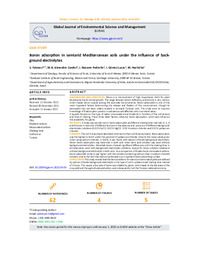Título :
Boron adsorption in semiarid Mediterranean soils under the influence of background
electrolytes |
Autor :
Fatnassi, Ibrahim 
Almendro-Candel, María Belén 
Navarro-Pedreño, Jose 
Gómez Lucas, Ignacio
Saber, Hachicha  |
Editor :
Global Journal of Environmental Science and Management |
Departamento:
Departamentos de la UMH::Agroquímica y Medio Ambiente |
Fecha de publicación:
2022-01 |
URI :
https://hdl.handle.net/11000/34750 |
Resumen :
BACKGROUND AND OBJECTIVES: Boron is a micronutrient of high importance, both for plant
development and normal growth. The range between boron deficiency and toxicity is very narrow,
which makes boron unique among the essential micronutrients. Boron adsorption is one of the
most important factors determining the release and fixation of this micronutrient, though its
adsorption has not been widely studied in semiarid Tunisian soils. This study aims to improve
knowledge of B adsorption process in calcareous salt-affected soils in semiarid areas.
It equally focuses on the type of cation (monovalent and divalent) in function of the soil texture
and time of shaking. These three latter factors influence boron adsorption, which also influence
the availability for plants.
METHODS: A study was carried out on boron adsorption at different shaking time intervals (1, 3, 6
and 9 hours) in two soils of different textures in the absence and presence of different background
electrolytes solutions (0.02 N CaCl2, 0.02 N MgCl2 , 0.02 N sodium chloride and 0.02 N potassium
chloride.
FINDINGS: The soil-A (clay loam) adsorbed more boron than soil-B (sandy loam). Boron adsorption
was the highest in Soil-A under the presence of potassium chloride, close to the mean values given
when using calcium chloride. In Soil-B, it was found with calcium chloride background electrolyte.
Minor boron adsorption was observed in both soils when boric acid solution was used without
background electrolytes. Adsorbed boron showed significant differences with the shaking time in
all treatments used with background electrolytes solutions, except for boron solution treatment
without background electrolyte in both soils. As a comparison of divalent and monovalent cations,
boron adsorbed content was higher with the solution containing calcium than in sodium chloride
solution, due to the fact that calcium carbonate is an important boron adsorbing surface.
CONCLUSION: This study reveals that the best conditions for maximum boron adsorption are defined
by calcium chloride background electrolyte in this type of soil in a determined shaking time interval
of 3 hours. This causes a low rate of boron assimilated by plants, which leads to the decrease of the
crop yield and the agricultural production, and subsequently hurt the Tunisian national economy
|
Palabras clave/Materias:
Clay
Divalent cations
Monovalentcations
Shaking time
Soil textur
Tunisia |
Área de conocimiento :
CDU: Ciencias aplicadas: Ingeniería. Tecnología |
Tipo de documento :
info:eu-repo/semantics/article |
Derechos de acceso:
info:eu-repo/semantics/openAccess
Attribution-NonCommercial-NoDerivatives 4.0 Internacional |
DOI :
https://doi.org/10.22034/gjesm.2022.04.05 |
Publicado en:
Global J. Environ. Sci. Manage. 8(4): 519-532, Autumn 2022 |
Aparece en las colecciones:
Artículos Agroquímica y Medio Ambiente
|
 La licencia se describe como: Atribución-NonComercial-NoDerivada 4.0 Internacional.
La licencia se describe como: Atribución-NonComercial-NoDerivada 4.0 Internacional.
.png)
